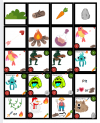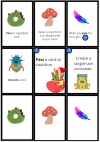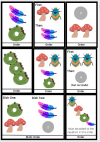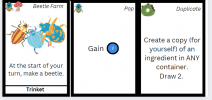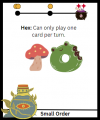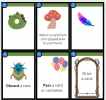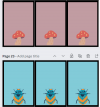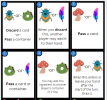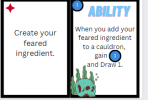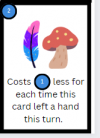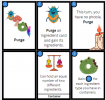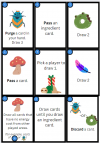I'm in the early stages of working on an asymmetrical cooperative deckbuilder. For me mechanics come first and theming last, but roughly:
- one player is the town
- one player defends the town
The Circle of Life
Each card has a battle side (top) and a town side (bottom).

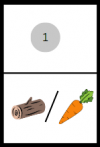
In this game, there is no discard pile. When you play (or discard) a card, it goes to the bottom of your partner's draw pile. Cards you don't play go back to the bottom of your own draw pile.
Tying this idea together is the design that cards tend to be better on one side or the other. Your strong attack card tends to have a weaker economy side, so when you're playing you always have to balance what's good for your role versus the needs of your partner.
Situational Needs
In order to make the choice of what to play (and therefore circulate to your partner) more meaningful, the players will face enemies that need specific answers. Damage in this game is typed, and often a monster's health bar will only go down if damaged by the corresponding damage type. Some monsters even interact with the town's resources. You slow down the Gruncher by feeding him some rocks, and the "Vampire?" has to be finished off by a wooden stake.
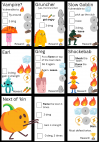
The Flow of Battle
In Spire, battles tend to last from 3-7 turns, but that sort of setup makes things really awkward in this kind of environment. What should the battle player be doing when a battle is over? You don't want to punish the players for killing enemies quickly (giving them less economy time)
There are a number of approaches I've considered (and could still consider). Maybe you view it less as a "defense", and let your hero go defeat as many enemies as they can in a fixed number of turns.
The current approach is to have a new enemy (max 3 concurrently) enter battle every turn. Some enemies will leave on their own after some time, and the players can prioritize which enemies to... erm, prioritize.
The Town
The player playing the town is the one in charge of new card acquisition. They'll see at all times an offer of cards that they can buy with the resources they generate. When they buy a card they put it on top of the draw pile of their choice (top of the library manipulation!).
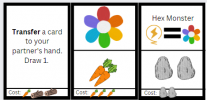

Overall Flow and Unknowns
The idea I currently have is that at various timepoints the town player will select certain buildings to build in the town. When you build a building, you take that building's corresponding set of cards (10-20 cards?) and shuffle them into the offer. Games where you open Blacksmith -> Witch's Hut would play out very differently than Lumber Yard -> Chapel, or whatever. It also allows you to develop some different mechanical semi-parasitic stuff, since you know the matching cards would be in the cardpool.
Still a lot to work on. Some ideas I quite like (the flow of the two decks), some are rough (enemy design) and some are super garbage at the moment (player card design). Have a friend coming over to playtest this weekend, excited but mostly terrified as I'm sure the design will completely fall apart!
- one player is the town
- one player defends the town
The Circle of Life
Each card has a battle side (top) and a town side (bottom).


In this game, there is no discard pile. When you play (or discard) a card, it goes to the bottom of your partner's draw pile. Cards you don't play go back to the bottom of your own draw pile.
Tying this idea together is the design that cards tend to be better on one side or the other. Your strong attack card tends to have a weaker economy side, so when you're playing you always have to balance what's good for your role versus the needs of your partner.
Situational Needs
In order to make the choice of what to play (and therefore circulate to your partner) more meaningful, the players will face enemies that need specific answers. Damage in this game is typed, and often a monster's health bar will only go down if damaged by the corresponding damage type. Some monsters even interact with the town's resources. You slow down the Gruncher by feeding him some rocks, and the "Vampire?" has to be finished off by a wooden stake.

The Flow of Battle
In Spire, battles tend to last from 3-7 turns, but that sort of setup makes things really awkward in this kind of environment. What should the battle player be doing when a battle is over? You don't want to punish the players for killing enemies quickly (giving them less economy time)
There are a number of approaches I've considered (and could still consider). Maybe you view it less as a "defense", and let your hero go defeat as many enemies as they can in a fixed number of turns.
The current approach is to have a new enemy (max 3 concurrently) enter battle every turn. Some enemies will leave on their own after some time, and the players can prioritize which enemies to... erm, prioritize.
The Town
The player playing the town is the one in charge of new card acquisition. They'll see at all times an offer of cards that they can buy with the resources they generate. When they buy a card they put it on top of the draw pile of their choice (top of the library manipulation!).


Overall Flow and Unknowns
The idea I currently have is that at various timepoints the town player will select certain buildings to build in the town. When you build a building, you take that building's corresponding set of cards (10-20 cards?) and shuffle them into the offer. Games where you open Blacksmith -> Witch's Hut would play out very differently than Lumber Yard -> Chapel, or whatever. It also allows you to develop some different mechanical semi-parasitic stuff, since you know the matching cards would be in the cardpool.
Still a lot to work on. Some ideas I quite like (the flow of the two decks), some are rough (enemy design) and some are super garbage at the moment (player card design). Have a friend coming over to playtest this weekend, excited but mostly terrified as I'm sure the design will completely fall apart!

